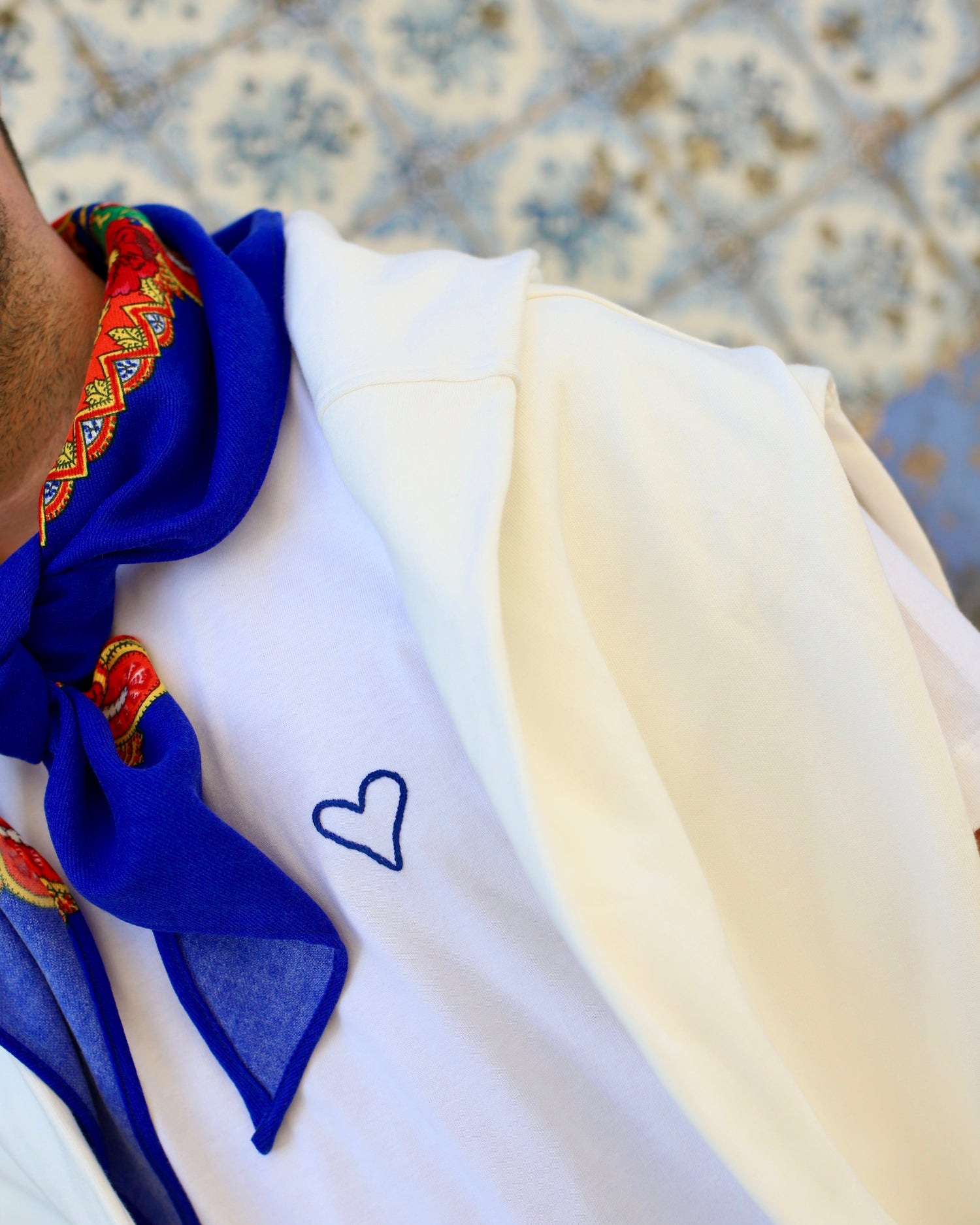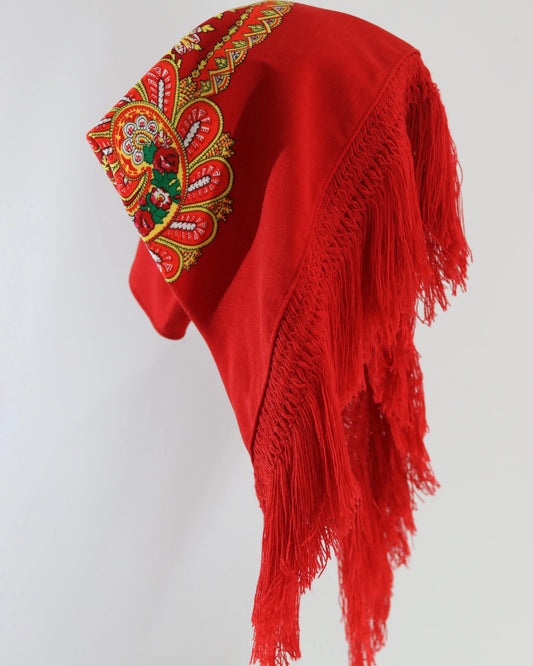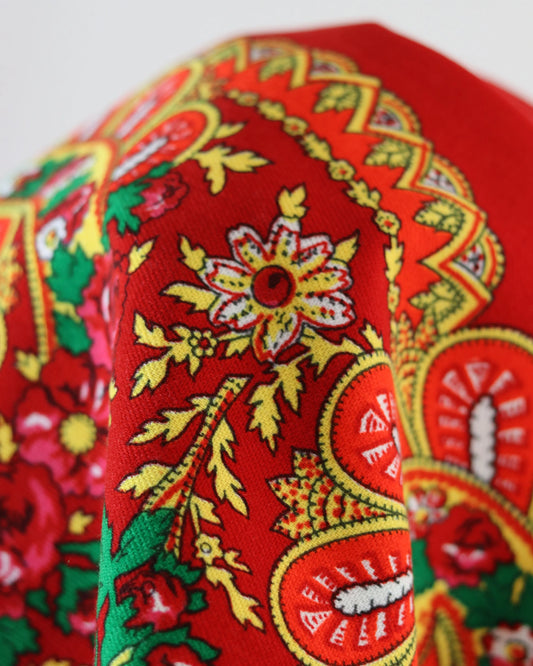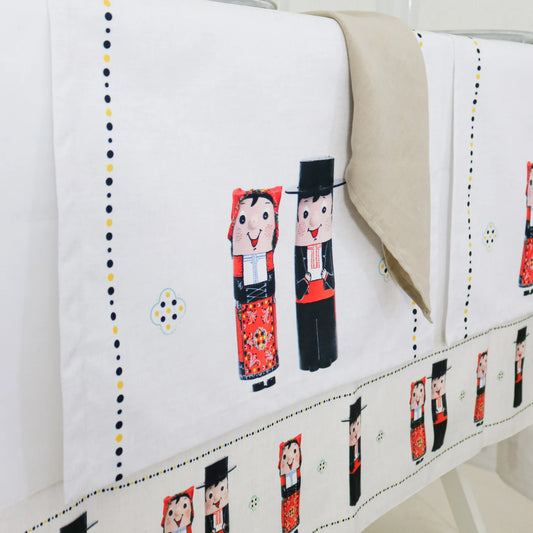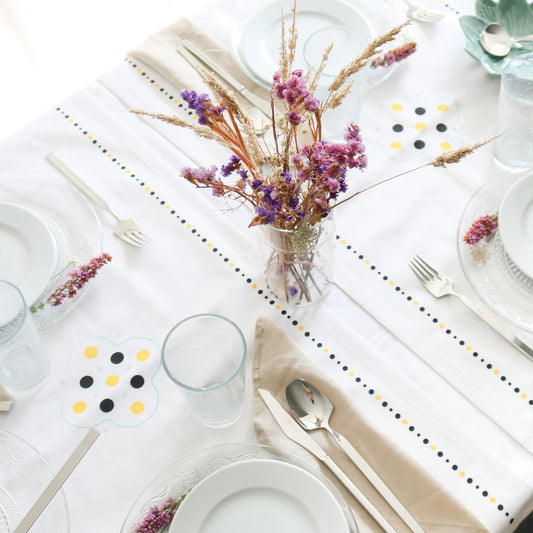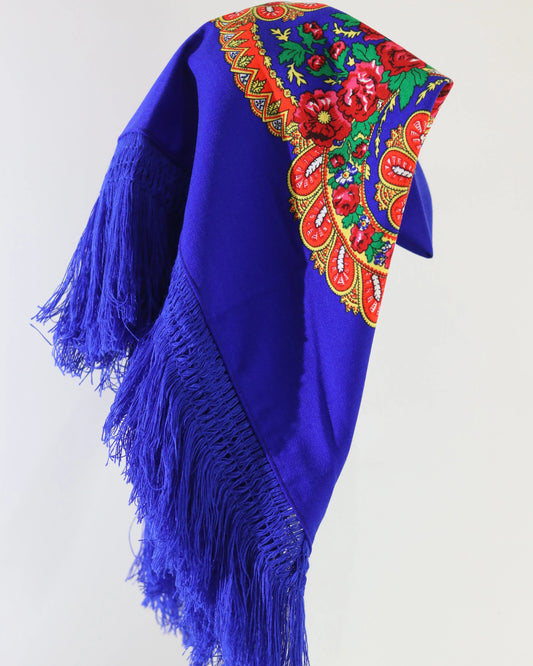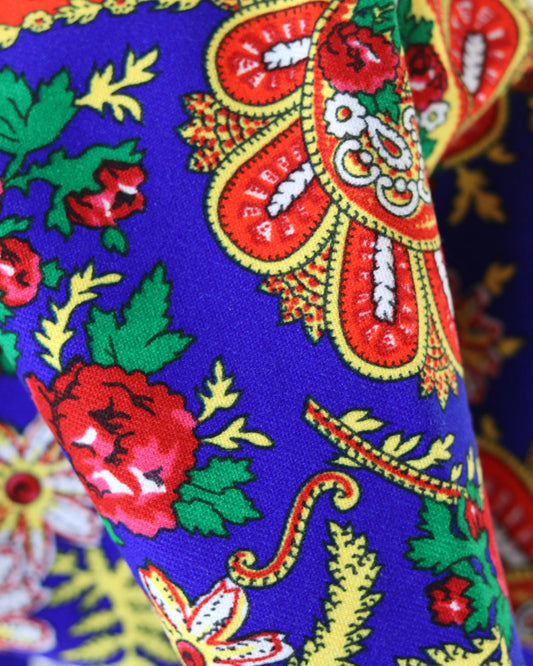Viana scarves: tradition and fashion
As you turn the corner of Praça da República in August, you see a sea of color and movement. It's Viana do Castelo in celebration. Amidst gold , embroidery, and woolen skirts, square cloths fluttering like intimate flags stand out. They're small in size but immense in meaning, like the iconic Viana scarves, whose history dates back to ancient times. They carry stories of women, parishes, and a city that knew how to transform an ornament of distant origin into a greater symbol of identity.
What defines the Viana's Handkerchiefs
Aesthetically, there are elements that stand out:
- Square shape, with a central design and an ornamental finish near the edges
- Long bangs, made and applied by hand
- Prints rich in floral motifs, cornucopias, branches, sometimes hearts
- Saturated, bright colors: fiery red, deep blue, canary yellow, purples, and oranges
Functionally, the traditional peasant's attire required two fringed scarves: one on the head, the other crossed over the chest, often referred to as Viana scarves. The combination isn't random; it's a visual language. In Viana and its surrounding areas, each parish developed its own color preferences, signaling local affiliations and festive traditions.
It's important to remember that these are printed items, not embroidered. The difference is significant for those who confuse them with embroidered shoulder cloths from other regions. The design is created in a factory, arrives in rolls, and the finishing touches are done by the hands of Viana who cut, hem, and fringe. This is part of their character.
Where did they come from and how did they become Viana residents?
Women from Alto Minho didn't always wear these wool or silk styles. Until the mid-19th century, chintz scarves from Alcobaça predominated. From the 1870s onward, fine wool "veils" with detailed prints and fringes arrived, imported from abroad. They quickly became popular locally.
There are fascinating accounts. In 1852, during the visit of Queen Maria II, young women from Geraz do Lima adopted green, a color associated with the House of Braganza. In 1885, Ramalho Ortigão described the Viana market covered in red, blue, yellow, and purple scarves, like a portable garden. Foreign fashions intertwined with the region's festive customs and crystallized into a costume that would become a national icon.
The incorporation was organic. Families, parishes, charities, and, later, folk groups established styles and rules for proper dress. In the 20th century, scholars and collectors set about documenting and teaching them. Today, the Costume Museum, the city government, and cultural associations keep this knowledge alive.
Craft and technique: from the roll to the finish
The contemporary production process combines industry and craftsmanship:
- Design: local artisans and houses research ancient patterns and create new compositions, always within the traditional grammar.
- Printing: the designs go to specialized factories abroad, which print the fabrics on fine wool or silk (and in some cases cotton).
- Finishing: back in Viana, the roll is cut, the small hem is made, and the fringes are added by hand, stitch by stitch.
For decades, many artisans fringed their own scarves at home. Today, teams of retired embroiderers and small workshops share the work. The raw material has evolved: the market for acrylics has led several local manufacturers to invest in wool and silk, offering better feel and drape. In prints, the public has learned to recognize the circular cornucopia popularized between the 1910s and 1920s, but older models are also resurfacing, with pointed cornucopias.
There's coherence throughout: restrained innovation, fidelity to the underlying motives, and quality of execution. It's in this combination that its strength lies.
Colors that speak of places
For a long time, red dominated the imagination. Even today, it's the color most associated with celebration and luxury. But the color palette is rich.
- Areosa: predominance of intense red
- Afife: canary yellow on the head, orange on the chest
- Geraz do Lima: green consecrated after the royal visit of 1852
- Other parishes: blues, purples and mixtures that mark parish identities
This play of colors creates a silent dialogue between the villages. During the procession, the trained eye can read the geography through the fabric.
Summary timeline
| Year | Event | Impact on scarves |
|---|---|---|
| 1852 | Girls from Geraz do Lima wear green scarves on royal visit | Symbolic fixation of local color |
| 1870–1880 | Massive arrival of “foreign” scarves in fine wool | Consolidation of the shape and fringe |
| 1885 | Ortigão describes the colorful Viana market | Literary validation of festive use |
| 1919 | 1. Regional Dance and Descant Competition | Public promotion of the costume |
| 1920s–30s | Folklore groups emerge from Alto Minho | Dissemination and systematic study |
| 2013–2016 | Specifications and official records | Technical protection and standardization |
| 2018 | Political recognition of the potential for UNESCO | National projection |
| 2020 | Listing as Heritage of Municipal Interest | Legal and cultural appreciation |
Stages where they shine
The main showcase is the Pilgrimage of Our Lady of Agony , held in August. On the Saturday of the Stewardship , hundreds of women cross the city in a procession that resembles a river of fringes and cornucopias. Sunday brings the devotion to the docks, in the Procession to the Sea . In 2023, nearly a thousand women from various countries paraded in the costume, in a transnational demonstration of belonging.
The week also includes:
- Costume Festival: a commented show, where each parish presents its outfit, piece by piece
- Craft Fair: Dozens of local artisans showcase and sell genuine Viana scarves, gold, and embroidery.
- Meetings of square dance groups and folklore groups that keep the costume outside the pilgrimage calendar
These events serve as an outdoor school. The tradition gains new practitioners and critical eyes.
From costume to catwalk: fashion with roots
The 21st century brought a rapprochement between traditional attire and urban wear. Several local designers and brands have transformed Viana's repertoire into design material.
- Isabel Lima brought a broad interpretation of parish attire to the catwalk, highlighting silhouettes, colors, and accessories.
- Del Rio Classic combines contemporary cuts with details and fabrics reminiscent of fringed fabrics.
- Amor com Graça brings prints and colors to children's accessories, in a light style.
- Coisas com Gosto transcribes the grammar of scarves and filigree on decorative wooden objects.
- Artisans like Ricardo Mónica investigate forgotten patterns, redesigning them for current production, always with hand-woven fringe.
The result is visibility. On social media, at fairs and fashion shows, the scarf leaves its strictly folkloric framework and coexists with blazers, jeans, and plain dresses. This coexistence only works because there's substance behind it: techniques, patterns, and a community that legitimizes them.
How to use it today without losing your bearings
Styling proposals for everyday life:
- On the neck: short simple nut, leaving the ends and fringe exposed
- On the shoulders: large triangle, held in place by a discreet pin
- On the head: low knot at the nape of the neck, with the tip of the scarf centered on the forehead
- On the wrist or handle of your bag: a touch of color that doesn't weigh you down
- Improvised belt: rolled up and passed through belt loops, creating contrast in a neutral piece
Two golden rules:
- The scarf takes center stage. Give it space with plain pieces and clean cuts.
- Bangs require movement. Avoid hiding the kick, which is part of the beauty.
Authenticity, certification and the role of institutions
The city organized to protect its textile heritage, highlighting the history of the region's iconic scarves. The Specifications Book defines the materials, proportions, and techniques of the Vianesa costume, including parameters for fringed scarves. The city's heritage designation reinforces the public's commitment to safeguarding them.
The Costume Museum has become a center for study and dissemination: collections, exhibitions, and workshops bring students, visitors, and artisans together. Figures like Francisco Sampaio have contributed to transforming parties and costumes into topics of cultural policy, responsible tourism, and education.
There's a clever balance here. While acknowledging that the fabrics are of industrial and sometimes foreign origin, they protect their design, local finishing practices, and coherence with the larger garment that gives them meaning.
Quick Buying and Care Guide
Quality checklist when purchasing:
- Fabric feel: Fine wool or silk has body and drape; acrylics are light and inconsistent.
- Sharp print: defined contours and deep colors
- Hand-cut fringe: check the knot and insertion; too much uneven work can indicate poor execution.
- Small and discreet hem
- Information about the craftsman or Viana house responsible for the finishing
Home maintenance:
- Hand wash, cold water, mild detergent
- Do not twist; press with a towel to remove excess water.
- Dry horizontally
- Iron with a protective cloth, temperature suitable for the fiber
- Store flat or rolled up; avoid folding in the same place to avoid creasing the print.
Repairs:
- Loose bangs can be remade by local artisans
- Small breaks in the weave can be resolved with a fine reweaving technique.
- If the problem is in the print (fading), there is no cure; prevent it by washing it carefully and avoiding sun exposure.
Reasons that tell stories
The history of Viana scarves shows that their patterns are not mere ornaments. Cornucopias, flowers, and plant scrolls speak of abundance, fertility, and celebration. The heart, which in Viana finds its most famous expression in gold , sometimes also appears subtended in the fabric's arabesques. There is a visual continuity between the cloths, beaded pockets, sequined vests, and filigree. Everything points to the same goal: to create an opulent, joyful, and irresistible ensemble.
Repetition is part of language. Even when a craftsman reinterprets an old design, the grammar is recognized: symmetry, blossoming from the center, edges that frame the piece. This vocabulary allows for innovation without distorting the design.
Fashion, tourism and local economy
Each pilgrimage mobilizes residual but relevant value chains: fringe workshops, gold shops, tailors, linen and wool vendors, dance schools, folklore groups . The scarf, more affordable than an embroidered skirt or vest, is often the gateway for many visitors who want to take home an authentic fragment of Viana, especially the traditional Viana scarves.
Three points that make the difference:
- Transparency in origin and finish
- Price compatible with real manual work
- Inclusion in local networks of artisans and recognized stores
When these three come together, the object that arrives in the buyer's closet is more than a souvenir. It's a conscious participation in a living tradition .
Frequently asked questions
- Is it "wrong" to wear a Viana scarf outside of a full outfit? No. Urban and creative use is common and welcome, as long as it respects the garment and its aesthetics.
- Are there 100 percent local scarves? The designs and finishes are from Viana. The fabric printing is industrial and done locally. This has been the case since the 19th century.
- How to recognize a reissued antique pattern? Look for references to the artisan's dates and research background. Spouted cornucopias, for example, are reminiscent of turn-of-the-20th-century designs.
- What color to choose? Red is classic and photogenic. Blue offers sobriety. Green has a history in Geraz do Lima. Yellow and orange brighten the face. The best color is the one that complements your wardrobe.
A symbol that is used
Viana's scarves and Viana's fringed cloths aren't confined to shop windows. They live on the body and in the streets. They enchant those who arrive and reaffirm those who already belong. The city has successfully transformed imports into its own brands, returning them to the country as heritage. Between the hand that fringes and the step that parades, there's a chain of trust that spans generations.
Perhaps this is the secret to its enduring appeal. A textile object at once useful, beautiful, and distinctive. A color that illuminates faces. A design that moves with the wind. And a memory that is renewed every time someone, for the first time, picks up a scarf and holds it to their chest.



